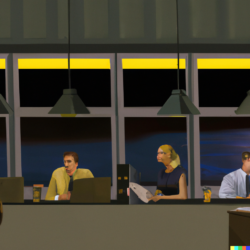October 10, 2023
Half of workers are either bored or knackered
 Almost half of employees are either bored or exhausted and many are both, according to new research from emlyon business school and published in the Journal of Vocational Behaviour [paywall]. The study, conducted by Lotta Harju, Professor of Work and Organisational Psychology at emlyon business school, investigated the prevalence and persistence of boredom and exhaustion manifest among Finnish and UK workers. Nowhere in the paper do the researchers use the term ‘knackered’. That’s down to us.
Almost half of employees are either bored or exhausted and many are both, according to new research from emlyon business school and published in the Journal of Vocational Behaviour [paywall]. The study, conducted by Lotta Harju, Professor of Work and Organisational Psychology at emlyon business school, investigated the prevalence and persistence of boredom and exhaustion manifest among Finnish and UK workers. Nowhere in the paper do the researchers use the term ‘knackered’. That’s down to us.
Furthermore, the researcher suggests that the employees’ experience of exhaustion and boredom did not change of a study period of 18 months, or if it did, it changed towards worse. The researchers carried out two studies, the first was a questionnaire sent to UK-based employees, the second was two questionnaires (18 months apart) to employees in 40 Finnish municipalities. The study shows that the reason why employees can be both bored and exhausted lies in job demands that hinder the performance of work, such as red-tape, organisational regulations and role conflict.
“The findings show that bored employees are often exhausted and that this is not just a passing experience but prevails and persists at workplaces.” says Lotta Harju. “Merely intensifying work may not be an effective cure for all boredom at work and may even backfire by straining the employees. Reducing those aspects of work that make it unnecessarily complicated for the people to perform may be a better way to improve overall well-being of the employees,” Harju adds.
The study uses data from over 2700 employees and was published in the Journal of Vocational Behaviour.
Abstract
Boredom and burnout are suggested to develop from opposite conditions: Whereas boredom is associated with low job stressors, burnout is driven by high job stressors. However, little empirical research exists on the relations between different types of stressors and boredom at work vis-à-vis burnout. Moreover, the direction of these relations has not been previously examined. Drawing from control – value theory and the challenge – hindrance stressor framework we used two-wave panel data from 1730 employees to examine cross-lagged relations between two types of job stressors (i.e., workload and red-tape), boredom and burnout.
Results of structural equation modelling revealed that both workload and red-tape positively predicted burnout, while only red-tape positively predicted job boredom over the follow-up period. Furthermore, we found that while burnout positively predicted both perceived workload and red-tape, boredom negatively predicted both types of stressors. We also found a positive reciprocal relation between boredom at work and burnout. These results imply that boredom and burnout may have partly distinct antecedents and outcomes, but they may also fuel each other in a way that requires further research. Implications for practice are discussed.














